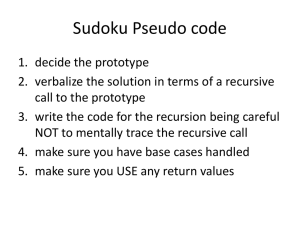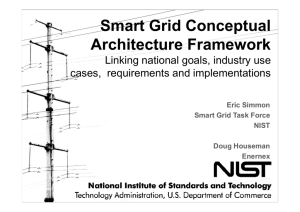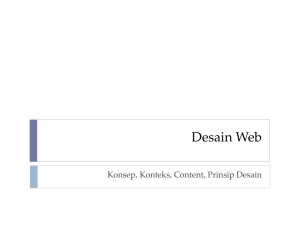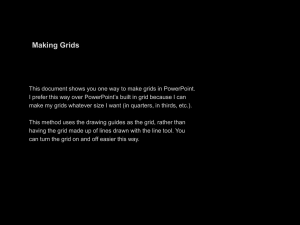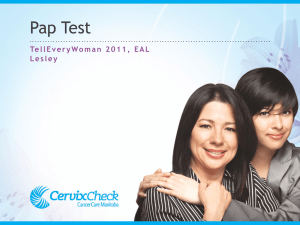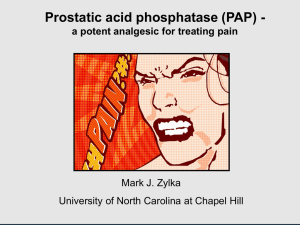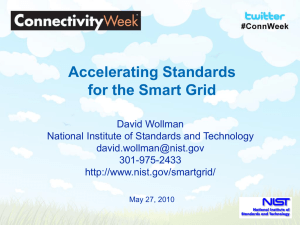Bootcamp - Use Case Process with SG Systems TOGAF
advertisement
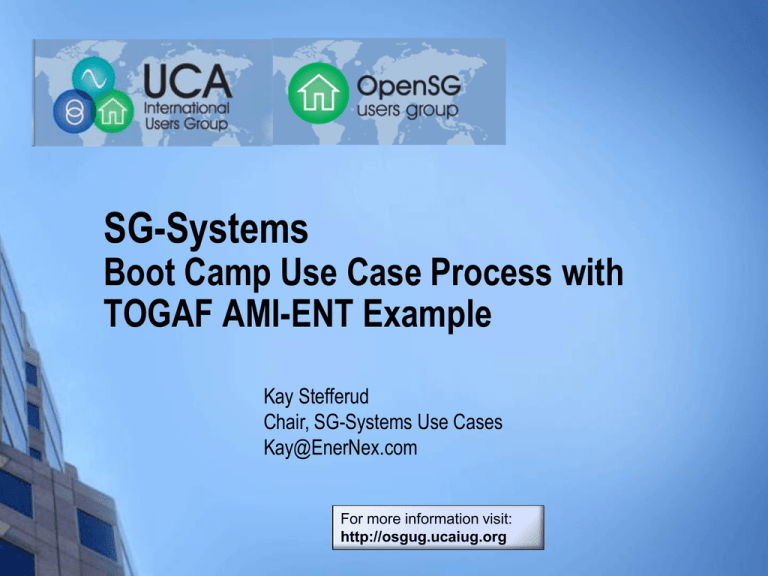
SG-Systems
Boot Camp Use Case Process with
TOGAF AMI-ENT Example
Kay Stefferud
Chair, SG-Systems Use Cases
Kay@EnerNex.com
For more information visit:
http://osgug.ucaiug.org
OpenSG Mapped to NIST Priority Action Plans
(PAPs)
SGIP - SGAC
Open Smart Grid
(OpenSG)
PAP 3 Price Model
PAP 4 Common Scheduling
PAP 9 Demand Response/DER
PAP 10 Energy Usage Info
Subcommittee
SG Security
(UtiliSec)
SG Communications
(UtiliComm)
Working Group
Working Group
NIST
Phase 3 SGIP
SGTCC
SG Systems
Working Group
SG Conformance
(CWG)
Working Group
(Proposed)
AMI-Security
AMI-Network
OpenHAN
Edge Conf
Task Force
Task Force
Task Force
Task Force
OpenADE
Enterrpise Conf
Network Interop
Task Force
Task Force
ASAP-SG
SGIP - CSWG
Task Force
OpenADR
Task Force
PAP 1 Internet Role
PAP 2 Wireless
Security Conf
Task Force
Open AMI-ENT
PAP 5 Power Line/ Appliances
Task Force
UtilityAMI
Interest Group
Diagram courtesy of
Wayne Longcore
SG Systems Use Case Methodology
Detailed
System
Definition
Functional
Requirements
Use Case
Development
Functional
Decomposition
SRS
Service
Definitions
Use Cases: Best Practice for Requirements Development
SG Systems Mapped to NIST Roadmap
Open Automated
Data Exchange
OpenADE
Open Automated
Demand
Response
OpenADR
Advanced Metering
Infrastructure
Enterprise
AMI ENT
Open Home Area
Network
OpenHAN
SG Systems Use Case List
The Open Group Architectural Framework (TOGAF)
“The How”
Architectural Development
Method (ADM)
“The Crop Circle”
ADM Defines Phases of
Architecture Development
Cycle
OpenSG Process Mapped to TOGAF
• Business
Use Cases
• Roadmap
Phase A
Vision
• Initial
Implementation
Reference
Implementation
Phase
E
Solutions
Phase B
Business
Use Cases
Phase
D
Technology • Requirements
Specifications
System Requirements
Specification (SRS)
TOGAF’s 4 Architectural Domains
“The What”
1. Business
2. Data
e.g. Business Process
Model (BPM)
e.g. Common
Information Model
(CIM)
Domains
3. Application
4. Technical
e.g. Demand
Response (DR)
e.g. Technical
Requirements Manual
(TRM)
Use Case Enterprise Architect (EA) Example
uc Open Smart Grid
Manage Smart Grid
Generate Power
Manage Large
Scale
Production
Manage
Distributed
Generation
Manage Power
Delivery/Distribution
Manage Energy
Resource
Manage
MicroGrid
Manage
Storage
Manage Demand
Manage
Supply
Open SG Actors
uc Actors 4 Charts
ISO or Grid
Operator
Metering Agent
Distributor
Open
Smart
Grid
Settlement Agent
Small-Scale
Merchant
Generator
Billing Agent
Regulator
«role»
Demand Response
Provider
Customer
Residential
Customer
Customer
Commercial
Large C/I Customer
and Co-Generator
Customer
Industrial
The mission of the Open
Smart Grid is to transform the
electric grid infrastructure
into a smarter, more efficient
more reliable system using
open standards addressing
the needs of all stakeholders
including consumers, utilities,
regulators, energy service
providers, and industry.
Business Process Model – DR example
class Demand Response Business Process Model
«goal»
Maintain Reliability of
the Grid
Supply Profile
Distributor
(from Actors)
«signal»
«supply»
Manage Demand for Grid Reliability
Energy
Shortage/Congestion/Equipment
Failure
«signal»
Load Control
Transaction
Demand Response
Prov ider
(from Actors)
«load»
«uses»
Compliance
Customer
«signal»
«goal»
Achiev e Least Cost
Dispatch
ISO or Grid Operator
(from Actors)
«uses»
«load»
«signal»
Manage Demand for Economic Dispatch
Market condition that forces either buying
more energy at significant cost or reduce
demand to avoid the buy
«flow»
Automatic
Generation Control
(AGC)
«flow»
Spinning Reserv es
«flow»
Load Control Transaction Sufficient
to Av oid Buying Energy
«flow»
Non-spinning
Reserv es
Replacement
Reserv es
BPM – OpenADE Requirements Example
ID
OADE BR-P1
OADE BR-P2
OADE BR-P3
OADE BR-MD
Business Requirement
Ability for 3rd parties to be authorized and receive
user-specific pricing data from the utility.
Pricing data available from OpenADE shall be
specific to a user and measurement point (service
delivery point) and shall represent the customer
agreed rate, e.g. consumption threshold block tiers
and TOU (time of use) tiers, and buy and sell prices
for each block / TOU.
Ability for 3rd parties to receive indication of the
price tier applicable to each consumption
interval, e.g. Pricing tier (block and TOU) and
maximum instantaneous demand
Ability for Utilities or other authorized parties, to
send public and directed messages, including price
or program details and announcements, to users,
via authorized 3rd parties.
Data – Common Information Model (CIM)
obj ect Business Functions
IEC-61968 IRM
Distribution
Mamagement
NO- Netw ork Ops
External to
Distribution
Management
EMS - Energy
Management and
Trading
AM - Records and
Asset Management
Electric Distribution Netw ork
Planning, Construction,
Maintenance, and Ops
NE - Netw ork
Extension Planning
SC - Supply Chain
and Logistics
MC - Maintenance
and Construction
ACT - Customer
Account
Management
CS - Customer
Support
RET- Retail
OP - Operational
Planning and
Optimization
Generation and Transmission
Management, ERP, Supply Chain, and
General Corporate Serv ices
FIN - Financial
MR - Meter
Reading and
Control
PRM - Premises
HR - Human
Resources
Data – HAN EA example
analysis Business Context
Usage Data
Pricing Information
Third Party
Utility
Pricing Information
Pricing Information
«flow»
Usage Data
Usage Data
{Usage
Data}
Home Area Network
«actor,entity»
«actor,entity»
Technical – OpenADR EA Example
sd Remov e DR Resource
DR Asset Owner
DR Controlling Entity
Remove DR Resource()
Ack-DR Resource
Removal()
(from Actors)
(from Actors)
Technical -- OpenADE example
Questions
Use Cases are
Best Practice
for Requirements Development



